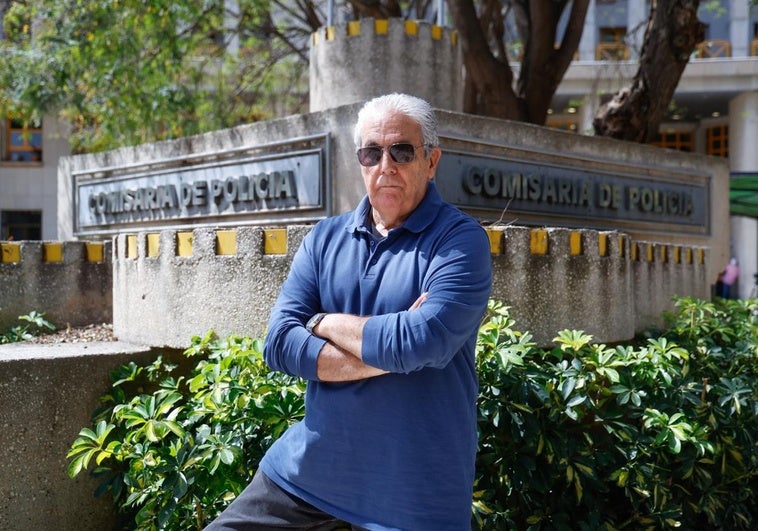
'Criminal organisations are like multinationals now and Marbella is the Wall Street of crime'
Juanjo Gómez Millán, a retired National Police chief who dedicated his career to tracking down the drug lords and kingpins of Russian and Irish gangs, has become the 'go-to' reference for new officers on the Costa del Sol
Monday 21 April. 8.15pm. Calahonda, Mijas on the Costa del Sol. A 30- year-old British man is shot following a football match. At least 10 bullets hit him. A few minutes later, some distance away, a Seat Cupra with foreign number plates is ablaze. Inside were two scorched pistols and the charred body of the victim. Just 48 hours later, the owner of a farm located in the same area found the body a man who had been handcuffed and with signs that he had dead for several days, which could be related to an alleged kidnapping that the National Police was already investigating.
The Costa del Sol is no stranger to crime, but the incidences are becoming more frequent and more violent. Although the authorities claim that the number of incidents is lower than last year and that there is no sign of an upturn. Those who follow the data are looking into the development of organised crime, which has been particularly significant for some time now.
"In the 1990s there were already settling of scores here, but they were more selective. Now they're more reckless, more cunning or cruder," says an 'old hand' of the National Police. His name is Juan José Gómez Millán, he is originally from Granada and joined the first team of what was then called International Crime II in Malaga where he spent two decades - from 1996 to 2016. It is now the organised crime group of Udyco (central narcotics until).
1992 football World Cup
He was 23 years old when he decided to apply to join the force. He passed at the first attempt and entered the training school in Badajoz (at that time there were four academies). His first posting was to Barcelona, coinciding with the 1982 Football World Cup. He also worked in Madrid and for citizen security at the Carabanchel police station. In the latter post, he says, he lived through the 'heroin war': "We seized about 45 kilos a year. That's a lot," he says.
Millán arrived in Malaga in January 1996. By then, the Costa del Sol had already established itself as the global headquarters of organised crime. As Millán recalls in an interview with SUR, the first to settle there were the British, in the 1960s, including those responsible for the famous great train robbery, which marked a point of no return in major robberies. "In those days there was practically no international cooperation and extradition treaties were nineteenth-century, so they took refuge here and began to buy land.
At the same time, tourism took off and the historic fishing villages of Malaga became the place to be for the jet set. Parties, luxury and ostentation, all in an unbeatable climate, made it a refuge for the rich and famous. Its strategic location, some 14 kilometres from Morocco - the world's largest producer of hashish - and barely an hour and a half's drive from Algeciras - one of the gateways for cocaine to the continent - and Gibraltar - a tax haven - meant that organised crime, largely linked to drug trafficking, took root in Malaga province.
Presence in Marbella
Gómez Millán says, "Organisations are like multinationals and Marbella is the Wall Street of crime, any self-respecting organisation has to have a presence on the stock exchange of organised crime. The heart of the matter is on the Costa del Sol and if you don't have a delegation here you are nobody". However, there are several factors that, in Millán's opinion, have led to an increase in violence on the very stage where business is being fought over.
On the one hand, "the mafias are increasingly recruiting younger people", he says, adding, "Several elements come into play here: what the Americans call a 'copycat' - if so-and-so leads a life of glamour and luxury, I want to aspire to it - and the myth of Pablo Escobar, a vulnerable child, lying on the street, who the organisation dresses, feeds and even provides accommodation for. At a younger age, there are generally fewer codes and more bravado."
On the other hand, Gómez Millán warns of an increase in gangs, not organisations. The former "are made up of several people brought together by a charismatic leader, they may specialise in committing any crime and have no rules"; the latter, on the other hand, "have structure and command. In order to identify them, we always recognised: hierarchy, selective use of violence, financial corporate networks for money laundering and the use of corruption".
Gómez Millán and his team were the scourge of the Tambovskaya (Russian mafia) or the Kinahan (Irish) during his 26 years of service. At 67, he has retired from the force, but continues to work as a 'reference book' for newcomers. He is still linked to the force through the Unified Police Union (SUP). However, he points out that "there are still not enough police officers".
